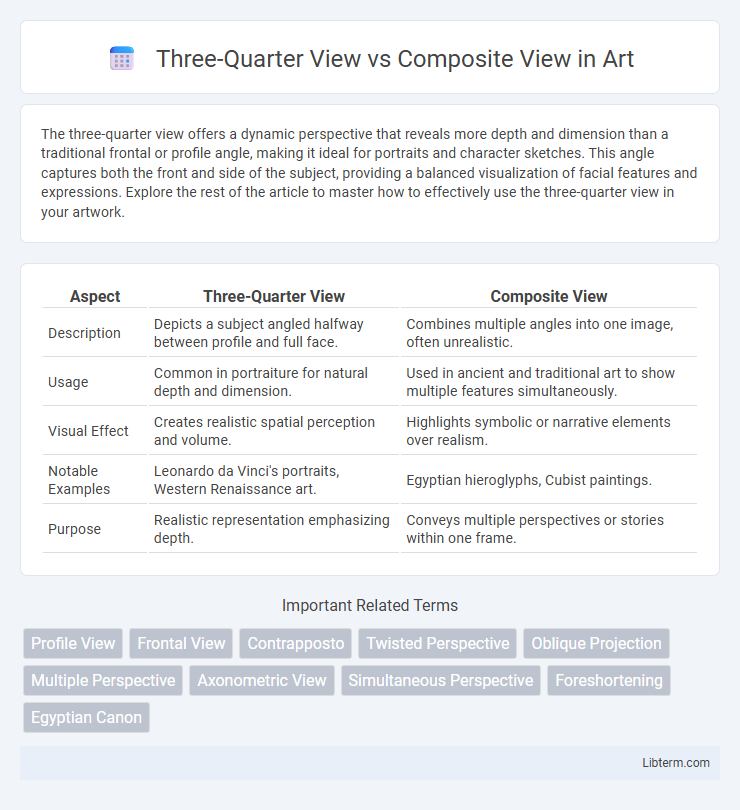The three-quarter view offers a dynamic perspective that reveals more depth and dimension than a traditional frontal or profile angle, making it ideal for portraits and character sketches. This angle captures both the front and side of the subject, providing a balanced visualization of facial features and expressions. Explore the rest of the article to master how to effectively use the three-quarter view in your artwork.
Table of Comparison
| Aspect | Three-Quarter View | Composite View |
|---|---|---|
| Description | Depicts a subject angled halfway between profile and full face. | Combines multiple angles into one image, often unrealistic. |
| Usage | Common in portraiture for natural depth and dimension. | Used in ancient and traditional art to show multiple features simultaneously. |
| Visual Effect | Creates realistic spatial perception and volume. | Highlights symbolic or narrative elements over realism. |
| Notable Examples | Leonardo da Vinci's portraits, Western Renaissance art. | Egyptian hieroglyphs, Cubist paintings. |
| Purpose | Realistic representation emphasizing depth. | Conveys multiple perspectives or stories within one frame. |
Introduction to Artistic Perspectives
Three-quarter view offers a dynamic representation by showing the subject at an angle between profile and frontal views, emphasizing depth and proportion in artistic perspectives. Composite view combines multiple viewpoints within a single image, integrating frontal and profile aspects to highlight essential features symbolically. Understanding these perspectives allows artists to convey realism and narrative complexity, enhancing visual storytelling.
Defining the Three-Quarter View
The three-quarter view captures a subject at an angle between profile and frontal perspectives, typically showing 45 degrees of the face or object. This viewpoint highlights depth and dimensionality, revealing contours that are less visible in flat, head-on images. It is widely used in portrait photography and design for its balance of detail and natural appearance.
Understanding Composite View
Composite View combines multiple perspectives of an object or subject, typically integrating front, side, and three-quarter angles to create a comprehensive representation. This approach enhances spatial understanding and visual depth by merging distinct viewpoints into a single cohesive image. Unlike the isolated Three-Quarter View, Composite View provides detailed contextual information, making it ideal for design, modeling, and artistic reference.
Historical Origins and Evolution
The three-quarter view originated in Renaissance portraiture, capturing depth and dimensionality by positioning the subject between profile and frontal views, enhancing realism and emotional expression. Composite view, often used in ancient Egyptian and Mesopotamian art, combines multiple perspectives within a single image to convey symbolic meaning rather than realistic representation. Over centuries, three-quarter view evolved with European artistic advancements emphasizing naturalism, while composite view maintained its prominence in cultural and religious iconography for conveying comprehensive narratives.
Key Differences between Three-Quarter and Composite Views
Three-quarter view offers a perspective showing three-quarters of a subject's face or object, focusing on depth and dimension, while composite view combines multiple perspectives into one image to present a comprehensive understanding. The key difference lies in the three-quarter view's realistic portrayal from a single angle versus composite view's integration of diverse angles for detailed analysis. This distinction impacts fields like art, design, and virtual modeling by influencing how visual information is interpreted and utilized.
Applications in Portraiture and Figure Drawing
The Three-Quarter View captures a subject turned slightly away from the viewer, emphasizing facial depth and dimensionality crucial for portraiture that aims to convey personality and emotion. The Composite View combines multiple angles into a single representation, often utilized in figure drawing to showcase a more comprehensive understanding of anatomy and movement. Artists leverage these perspectives to enhance visual storytelling, balancing realism and dynamic expression in their work.
Impact on Visual Storytelling
Three-Quarter View enhances visual storytelling by providing depth and dimension, allowing viewers to perceive characters or objects in a more lifelike and engaging manner. Composite View combines multiple perspectives into a single image, enriching narrative complexity and enabling the depiction of simultaneous actions or emotions. Utilizing these visual techniques strategically shapes audience perception and emotional connection within the story.
Common Artistic Techniques
The three-quarter view emphasizes showing the subject from an angle between profile and full face, highlighting depth and dimensionality in portraiture through techniques like shading and contouring. Composite view combines multiple perspectives, often front and profile, within a single image to represent a fuller understanding of the subject, commonly used in ancient Egyptian art and modern cubism. Both views utilize strategic perspective manipulation, light, and shadow to convey realism or narrative complexity, enhancing viewer engagement.
Advantages and Challenges
Three-quarter view provides a natural perspective by showing depth and facial contours, enhancing realism for portraits and character modeling, but it can be difficult to standardize for consistent analysis. Composite view combines multiple angles into a single image, allowing comprehensive visualization of features and reducing ambiguities, yet it can appear artificial and may require advanced software to generate accurately. Both approaches balance advantages in detail and representation with challenges in usability and production complexity.
Conclusion: Choosing the Right Perspective
Selecting the appropriate perspective depends on the intended use and context; a Three-Quarter View offers a dynamic, realistic representation that highlights depth and facial contours, ideal for portraits and character design. Composite View combines multiple angles into a single image, providing comprehensive detail useful in technical illustrations and detailed studies. Prioritize Three-Quarter View for visual appeal and emotional connection, while Composite View excels in clarity and informational completeness.
Three-Quarter View Infographic

 libterm.com
libterm.com